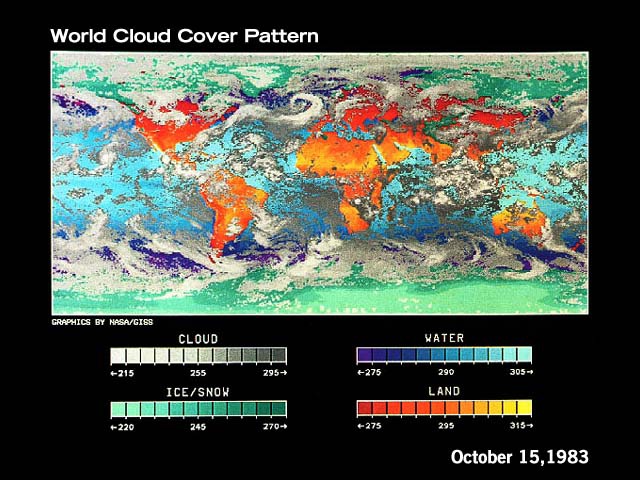The amount of cloud cover at various levels (low, middle and high) can be estimated from satellite data. For instance, Fig 1 shows the estimated global cloud cover from simultaneous observations on a series of geostationary satellites around the world (Note 8.J). Because the image is infrared, the brightness of the clouds is a measure of their heights.
Cloudiness can be calculated by counting the number of cloudy pixels on the satellite image, and this can be done for a large sample, to obtain climatologically meaningful estimates. These satellite-based estimates are generally less than ground-based ones, either by direct human observation or by inference from the duration of bright sunshine (1). The sunshine duration leads to an overestimate of cloudiness when the sun is close to the horizon (before sunset or after sunrise), especially when the cloudiness is cumuliform. Direct human observation attempts to compensate for the apparent obscuration of clear sky near the horizon, by the vertical extent of intervening low and middle clouds, but still most ground-based observers tend to overestimate cloudiness in these circumstances.
Compared to satellite estimates, human observations overestimate cloudiness by about 0.2 -0.0013f tenths of cloud (where f is the latitude in degrees), e.g. 0.15 tenths at 40°. This is because cumuliform clouds are more common at lower latitudes. Note that apart from using ‘okta’ units of cloudiness (i.e. eighths of the sky covered by cloud), we may express the fraction in ‘tenths’. In other words, 4 oktas equals 5 tenths.

Fig 1. Global cloud cover at 12 GMT on 15 October 1983, as estimated from infrared imagery on 5 geostationary meteorological satellites. The shadings are a function of the IR brightness temperature. (Source: NASA/GSFC)
